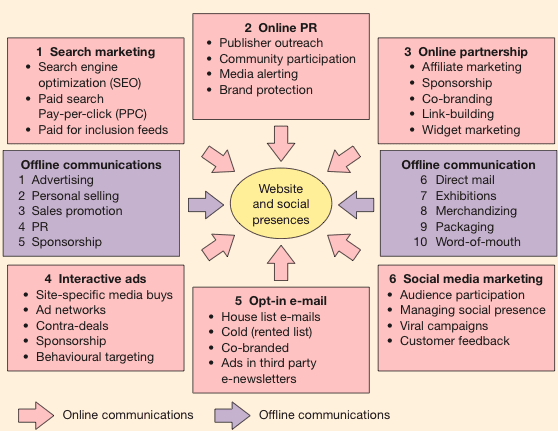Little fish have to keep moving all the time to avoid being swallowed up by the big fish. Start-up businesses constantly find themselves in a similar scenario when entering a market place that is dominated by giant category leaders. Entrepreneur Adam Morgan (2012) explains that in order to succeed, start-ups must “unceasingly adopt new ways to challenge and innovate the existing conventions of the category as well as the culture around it.” With money being a sensitive subject amongst most start-up SMEs, it makes perfect sense to stop what you’re doing, turn off your TV, put that cuppa on hold, and draw your close attention to the power of social media: a cheap and powerful medium to grow YOUR business.
So… Now I have your attention, let’s focus on how to tell when start-ups use social media, that Chaffey (2015) explains as a vital channel of marketing, to grow their customer base and how we can gauge effectiveness. Exciting stuff.

Source: 6 Key digital marketing tactics from Dave Chaffey’s Digital Marketing Strategy, 2015)
#HASHTAGGING YOUR WAY TO SUCCESS
It has become the norm for the everyday social media addict, like myself, to be confronted with a sea of #hashtags #everywhere #they #look (..you get my gist). Brands have to cunningly adopt this function and weave it into their campaigns on all leading social media platforms in order to generate noise amongst consumers which drives brand awareness. By creating an effective hashtag which is in the consumer’s interest to use (such as competitions, events etc), start-ups raise brand awareness with very little effort and cost. According to Cheung et al (2009), this is a vital channel of marketing and is named ‘Electronic Word-of-Mouth (eWOM)’. Below is one great example of this is where a baby food start-up, Piccolo, asks its customers to take photos of their babies with the product using the hashtag #PiccoloOfTheMonth to be in with the chance of winning a month’s supply, yummy!
So.. How on earth do you go about measuring a hashtag’s success I hear you ask? Rather than employ a number of staff to carry out the tedious task of exploring the consumer profile each like and share you receive, you can simply download a tool called Audiense that does it for you. Audiense is an electronic tool that not only accurately measures how many times your small business is mentioned or your hashtag is used, but it also breaks this information down into more detail such as who, what, where, when and how consumers are interacting with you using hashtags on social media. For example, Piccolo (figure 1), could use this cheap and easy tool to discover exactly how many times their unique hashtag was used across all social media or how many extra likes or followers they gained since the start of the campaign. They could also use Google analytics to measure the volume of consumers that clicked on their website link through their Facebook and Instagram pages to gauge which drives more traffic and where their attention should focus. This precious data is very precious to a start-up as it allows them to cheaply establish their target market for future campaigns.
You can watch more about Audiense’s work here.
SOCIAL MEDIA CUSTOMER SERVICE
With 64% of the UK population actively using social media (Statista, 2017), start-ups can take advantage of this to have direct contact with their customers online without the need of a large customer service department or system. By increasing brand transparency by communicating various issues with consumers publically on your social media, the wide range of people who view this form of effect customer service are more likely to trust and buy into your brand (Lazanyi, 2015). So.. What does effective social media customer service look like?
Here we have a great example of effective social media customer service from another start-up, just like you! The clear indication of whether a public gesture such as the Facebook live Q&A on the left is effective is from the engagement rate (ER) of the post. This is made up of 3 key elements: likes, shares and comments. If you cause consumers to interact with your post, their friends will see this which will consequently builds more effective brand awareness as eWOM from a friend is more effective than directly from the brand itself (Cheung et al,2009).
Here is yet another great example of effective customer service on a smaller less public scale on Twitter – take note! As you can see from the screenshot, the direct tweets between the brand and the consumer resulted in the consumer feeling special and therefore placing a large order of their popcorn. Kerching!
This is just a couple of simple ways you can boost your customer base using the power of social media, in the most simplest of ways. So what are you waiting for? Get out there on your social media platform and build your brand!
REFERENCES
Chaffey, D. & Ellis-Chadwick, F. 2015, Digital marketing, Sixth edn, Pearson, Upper Saddle River.
Cheung, M.Y., Luo, C., Sia, C.L. & Chen, H. 2009, “Credibility of Electronic Word-of-Mouth: Informational and Normative Determinants of On-line Consumer Recommendations”, International Journal of Electronic Commerce, vol. 13, no. 4, pp. 9-38
Lazanyi, K. 2015, “WHAT MAKES A START-UP SUCCESSFUL? – SMALL BUSINESS VENTURES IN FOCUS”, On-line Journal Modelling the New Europe, no. 16.
Morgan, A. 2012, “Eating the Big Fish: How Challenger Brands Can Compete Against Brand Leaders: Second Edition”





